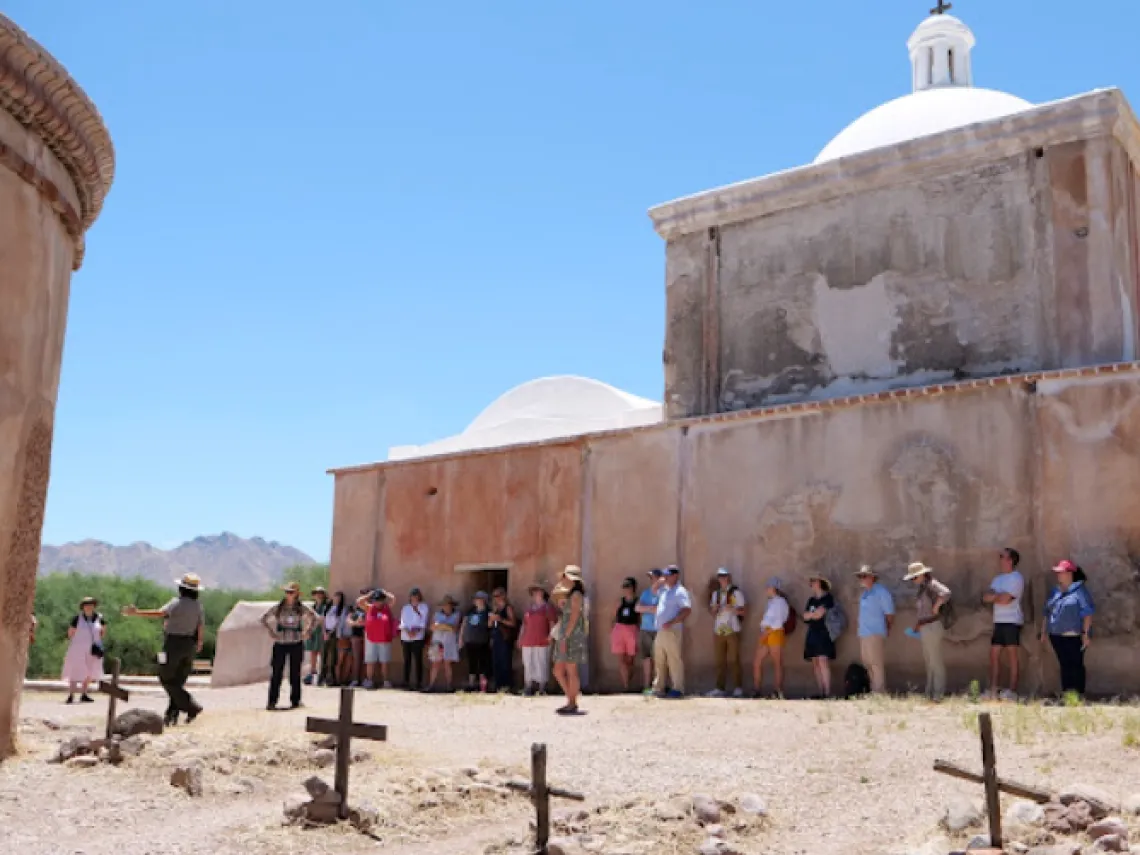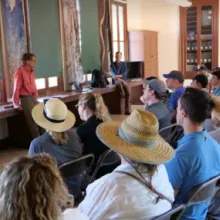With NEH Grant, UArizona Southwest Center Shares Arizona-Sonora Borderlands with K-12 Educators from Around the Country

Theresa Ferraro, interpretation ranger from the National Parks Service, talks about the Spanish colonial presence in the Southwest in Tumacácori National Historic Park.
In late June, 36 K-12 educators from all over the country came to Tucson for one week to receive hands-on learning about the Arizona-Sonora borderlands to take back to their classrooms. Another 36 teachers will begin the residential workshop on July 18, 2022.
To fund the workshops, the University of Arizona Southwest Center received an NEH Landmarks of American History and Culture Grant for the project "Arizona-Sonora Borderlands, Palimpsest of Cultures."

The Arizona-Sonora Borderlands is a palimpsest – which means reused or altered but still bearing the traces of an earlier form – of continuous human habitation dating back to at least 1200 BCE, said Jeff Banister, director of the Southwest Center and principal investigator of the grant.
“This is one of the longest human-inhabited areas of the United States,” Banister said. “It is a hub of complex ancient societies, clashing global empires, and dramatic desert and mountain landscapes. We wanted to make sure that our workshop participants would be able to convey this richness and depth to their students as much from the heart as from the mind. We wanted to share our passion with them.”
“Our idea is to get people here on the border, teach them about the cultures and the people who occupy these spaces and to offer an alternative to the media frenzy about what is going on the border,” added co-PI Jennifer Jenkins, professor in the Southwest Center and the Department of English.

During the workshop week, the educators learn about the history, arts, environments, and plural cultures of the Arizona-Sonora Borderlands in the context of past habitation and present conditions of tri-national (U.S., Mexico, Native Nations) coexistence.
The workshop’s framing question is: How do place, space, and identity intermingle in the region’s millennia of layered written, oral, aural, and visual histories to construct its futures?
It was a huge task to adequately convey the region’s richness and diversity in a week-long course, Banister said.
“We wanted our teachers to come away with a solid sense of the astonishing resilience that diverse peoples have shown in the face of oftentimes extremely adverse conditions, from colonialism and border militarization to the effects of human-induced global warming,” Banister said.
The educators visited a variety of places, including University Indian Ruin, Arizona State Museum, San Xavier del Bac, Tumacácori National Historic Park, The Desert Laboratory on Tumamoc Hill, Mission Garden, and the border wall. They heard from a variety of experts on topics related to ancestral and modern indigenous presence, Spanish colonialism, migration, and the environment.

The educators visited Nogales and the U.S.-Mexico border wall.
Participants will produce two items once the workshop concludes – a teaching portfolio which includes an individual lesson or curricular plan and an individual video log in which they reflect upon workshop content in relation to their own classroom or educational practice.
Rebecca Sheinberg lives in Houston and teaches students from all over the world as an online instructor. From her workshop experience, she plans to have her students research indigenous cultures and will present a unit on Native American poets and myths of the Tohono O'odham.
“The experience was amazing,” Sheinberg said. “The professors provided excellent resources and provided opportunities for collaborative exchanges. The sites we explored were great. I learned a great deal and met interesting people. It was truly a breathtaking experience.”
Kathleen Bowman teaches 5th grade in Tucson and said she was drawn to the program because “there is so much that I don’t know about where I call home.”
“The content we learned about enables me to better understand how today’s culture has been created from all of the groups of people that came before us in the Sonoran Desert,” Bowman said. “This will also be a powerful lesson for my students. As we work to build a generation of global citizens who are culturally aware and who celebrate diversity, we must first connect our students to their own community.”

